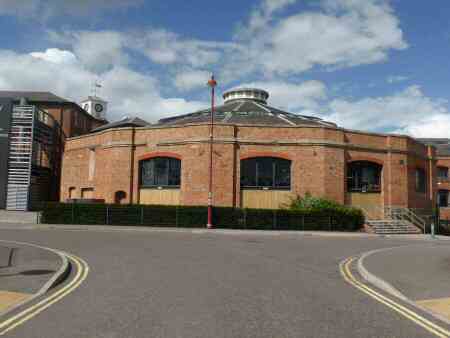RAILWAY QUARTER TRAIL - MIDLAND ROAD
DERBY RAILWAY QUARTER TRAIL 1
Derby’s historic Railway Quarter came to life on 30 May 1839, when the first railway train steamed into Derby stopping at a temporary wooden platform a little to the south of the present station
During the 1830s Derby was struggling to attract sufficient trade and as a result, a public meeting was held at the Town Hall in December 1835. It was decided that the lack of a good communication system, where goods could be moved quickly and inexpensively, was the main problem. Voting was unanimous to support petitions to be put before Parliament to bring the railways to Derby, and the following year Parliament passed an act allowing the existing railway network to be linked to the town.
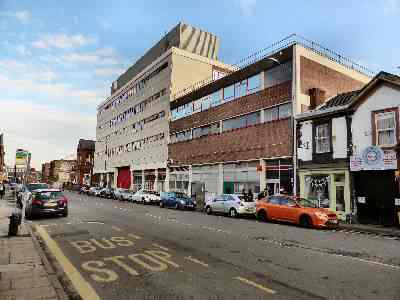
Three railway companies were involved in running lines into Derby, the Midland Counties, the North Midland Railway Company and the Birmingham and Derby Junction Railway Company. They decided that sharing a station would be the most inexpensive solution and, after considerable debate, a site was selected. It lay one mile to the southeast of the town, with only about one-third situated within the Borough, the remainder being in the small township of Litchurch.
It was on the 30 May 1839 at 1.18 pm that the first railway train steamed into Derby stopping at a temporary wooden platform a little to the south of the present station. The engine ‘Sunbeam’ completed the journey from Nottingham in 48 minutes, towing four first-class and two-second class carriages. Only one minute after the arrival of its predecessor, a second train ‘Ariel’ pulled into the station having covered the journey from Nottingham in 44 minutes. It later returned to its starting point and repeated the journey back to Derby in 31 minutes at an average speed of 30mph.
Five days later, the Midland Counties Railway Company started a regular passenger service between Derby and Nottingham. This was soon followed by the Birmingham and Derby Junction Railway, who began a regular service between the two locations, shortly after the opening ceremony on 5 August. However, it was the 30 June in the following year, before the North Midland line was opened to Leeds, a journey of 72 miles.
In 1840, Midland Road was constructed to link London Road to the Midland Railway Station. As the Midland Railway grew, so did its ability to attract new industries and bolster the old. In 1844, it was very much a parochial railway, but in 1867 it reached Manchester, a year later London, Swansea in 1874 and a year later again Scotland, via the Settle and Carlisle line.
W. W. Winter Ltd
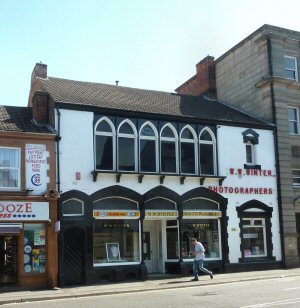
Winter’s is recognised as one of the oldest photography studios in the world. Its origins date back to the 1850s when Emmanuel Nicolas Charles established a photographic studio on Midland Road. Following his death in 1864, the studio was taken over first by his wife, and then in the same year by his former assistant Walter William Winter. At that time the studio was on the opposite side of the road to the present one.
Three years after taking the business over Winter had it moved across the road to take better advantage of the sunlight. The purpose-built studios were constructed to a design by the famous Derby architect Henry Isaac Stevens and have been listed as of special architectural and historical interest. In more recent times the business has continued to keep pace with the advances in technology and remains at the forefront of photography to this day.
The firm has published several superbly illustrated books featuring old photographs of Derby. It has received funding to restore, conserve, archive and make available to the public, many more images from the original glass plate negatives. A successful application to the National Lottery Fund has enabled the firm with the help of volunteers to start the archiving project.
Midland Road Post Office
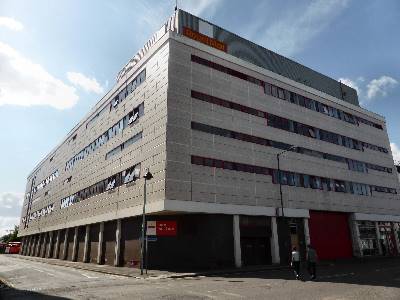
Facing down Carrington Street from the giant Midland Road Post Office building is Wellington Street, which leads to Midland Place where Bemrose Printers and Co built up a thriving business as a result of the popularity of rail travel. William Bemrose, who in 1840, for example, employed a staff of only twelve at his printing and stationery business in Derby Market Place, saw business increase dramatically. He was awarded the contract for Midland Railway timetables and stationery. By 1855 the number of workers had increased to 57 and in 1871 to 228. The organization continued to grow into the huge Bemrose Corporation, which employed many thousands of workers.
The arrival of the railways led to the expansion of many existing Derby businesses. Apart from Bemrose, another local firm to benefit was James Smith. He had launched his own business as a tailor in Cheapside only four years earlier when he was granted a contract, in 1844, to supply uniforms to Midland Railway staff. The first consignment was delivered in a handcart, but after that business expanded rapidly. A century later the firm made nearly two million uniforms during the Second World War.
Many other established Derby businesses also benefited from the arrival of the railways. Several other firms who moved to Derby were anxious to profit from the town’s rapid expansion.
Cenotaph
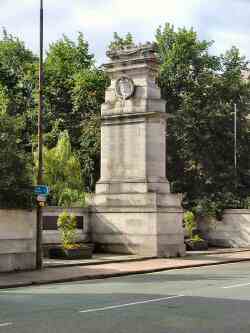
The Railway Cenotaph is situated further down Midland Road near the station. It was designed by Sir Edwin Lutyens, who also designed the Cenotaph at Westminster in London, and was erected in 1921 to commemorate the Midland Railway employees that lost their lives in the First World War.
During the war, 22,941 employees of the Company, whose base was in Derby, enlisted for war service. In total 7,068 were wounded and 2,833 killed. The names of the dead were inscribed on the memorial and also published in a commemorative book. A copy of which was sent to the families of the dead along with a free travel pass to the parents, widows and children of the fallen to visit the memorial. The memorial was listed as Grade II by English Heritage on 24 February 1977.
Midland Hotel (now Hallmark)
To meet the requirements of railway travellers, the Midland Hotel was built to a high standard by Thomas Jackson, the Pimlico builder, to the design by Francis Thompson, the Midland Railway architect. It was the first purpose-built railway hotel in the country, and is still one of the finest hotels in the city and has a four-star rating. The Hallmark Group bought the Grade II-listed, building in 2009 and refurbished its 102 rooms and its public spaces and re-named it ‘Hallmark’. In 2015, the hotel was ranked seventh in the country by the UK Online booking firm LateRooms, in the Boutique Hotel class.
The hotel was intended for first-class rail passengers and many famous people visited the Midland, including Queen Victoria in 1849. One entertainer who stayed there was Gracie Fields when she was at the height of her career. She was spotted at the hotel and an adoring crowd, gathered under her window to cheer. Realising what was happening; she opened the window and leaned out to wave to the crowd, with apparently the head porter hanging onto her legs fearful she might fall!
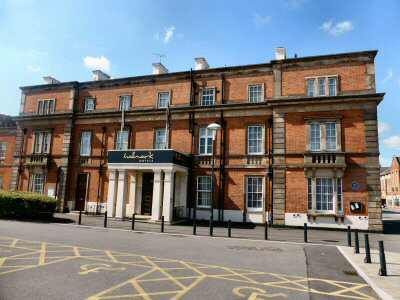
Originally, it was known as Cuff’s Midland Hotel, Cuff also being the manager of the station refreshment rooms. In 1862, it was purchased by the railway company and became the Midland Hotel. Further enlargement was carried out by the London Midland and Scottish when more bedrooms and bathrooms were added and the dining room was extended.
Following the nationalisation of the railways, British Transport Hotels were set up to act as a subsidiary of British Rail and they ran the Midland. Until a policy change by the government resulted in the selling off of assets and ownership switching to the Midland Hotels a private firm, in 1982.
Blue Plaque – William Towle
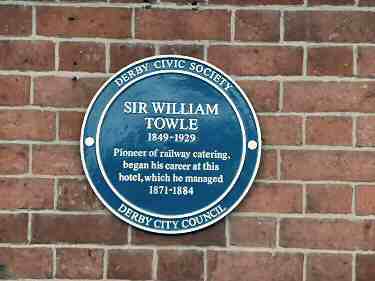
Given the title of ‘Father of railway catering’, William Towle had a blue plaque unveiled in his name in February 2015, outside the Hallmark Hotel, where Towle worked when it was known as the Midland Hotel. A local boy he grew up in a quiet country backwater between Swarkestone and Willington. Rather than follow in the footsteps of his father as a blacksmith he took up a position at the Midland Hotel. He gradually worked his way up the ladder and also became interested in outside catering.
In March 1874, the first lunch ever to be served onboard a train was handed out by Towle, who soon extended the choice available. He also introduced catering for economy classes providing the first lunchboxes and platform catering. All this convinced the Midland Railway Company, to make Towle the manager of its new upmarket railway hotel at St Pancras Station. From 1884 to 1914, Towle ran the hotel that earned a reputation of being one of the finest in the world, as well as controlling catering for the whole of the Midland Railway Group.
Midland Railway Station
Work on Derby Railway Station did not start until the autumn of 1839, and temporary arrangements were made for the intervening period between the commencement of railway services and the completion of the station. It was built by Thomas Jackson and designed by Francis Thompson and paid for by the North Midland Railway, the other two railway companies who also operated from the site being charged rent. It was completed during the summer of 1840. The extremely long platform of 1,050 feet, originally thought by some to be too large for requirements soon became very busy. The platforms were rebuilt in the early 1950s following war damage.
Cutthroat competition between the three railway companies led to a lack of cooperation in the sharing of the station and uneconomic pricing structures. The problem was solved in 1844 with the amalgamation of the three railway companies, forming the Midland Railway on 10 May 1844.
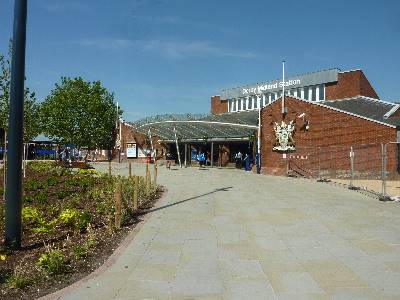
The arrival of the railways led to swarms of workers flocking to Derby to work. They came from all parts of the country and by 1851 records showed that 43% of the adults in the town had been born outside the county. The majority were employed in the railway works, where Locomotive, Carriage and Wagon, Signal and Telegraph works had been established. Others were employed by companies formed because of the railway’s arrival. Existing companies were able to expand for the same reason.
High standards of passenger comfort were established by the Midland. It was the first railway company to introduce Pullman car trains and it also abolished Second class status in 1875 and raised Third class standards. The company continued to expand and became the third-largest in Britain prior to its amalgamation into the LMS in 1923.
The Midland Counties led the World in providing cheap special excursions. Thomas Cook who was born in a small cottage in Quick Close, Melbourne in 1808, pioneered railway excursions for the company. As a result, Derby became the centre for the day excursion model, with the Midland encouraging those who had previously not travelled to do so and explore places previously unknown to them. For Cook, this was the beginning of what is today an internationally renowned business. The cottage he was born in has been demolished, but the almshouses he had built in Melbourne remain as a memorial, together with a garden dedicated to his memory.
The station slowly deteriorated over the years and although improvements and repairs were undertaken periodically, the main station buildings were urgently in need of costly repairs, so the decision to demolish was taken. Plans for a new modern station were drawn up and work began in December 1985. In order to retain a connection with the old station, the Coat of Arms of the Midland Railway and also the City of Derby are displayed on the front of the station. Further improvements have recently been carried out to improve the station and customer experience.
Midland Railway Clock
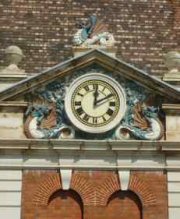
The redevelopment of the railway station in 1985 necessitated the demolition of the old station, but the station clock was saved. It was moved to the end of the Railway Terrace car park and is mounted on a plinth at the side of Wyvern House. This must come as something of a shock to visitors to see such an elegant-looking clock at the top end of a car park.
Following the amalgamation in 1844 of the three companies operating from the station and the formation of the Midland Railway, a new Coat of Arms was created for the enlarged company. The crest incorporated the Wyvern of Mercia with a wyvern, a legendary winged reptilian creature with a dragon’s head above the clock.
Roundhouse
The Roundhouse at Derby is the world’s first and oldest surviving railway roundhouse. However, the site with its storage sheds and historic locomotive turntable had been deteriorating, since it was for the most part vacated in 1990. The city council took over the site in 1994 when only the offices under the clock tower were occupied and the rest of the site was in a dilapidated state. This was recognised by English Heritage, who listed it the same year, along with the complex of listed buildings, in their Buildings at Risk Register. After several plans to save it had failed, this historic site is once again something that all Derby people can look on with great pride, following Derby College’s superb restoration.
